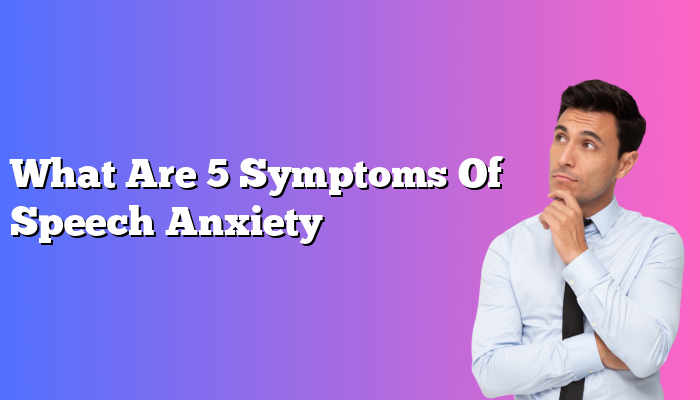We’ve all been there – standing in front of a crowd, heart racing, palms sweating, and suddenly it feels like our mind has gone completely blank. It’s no secret that public speaking can be a nerve-wracking experience, even for the most seasoned professionals. But for some individuals, this anxiety becomes so overwhelming that it interferes with their ability to effectively communicate their thoughts and ideas.
As speech pathologists, it’s important for us to recognize the symptoms of speech anxiety in order to provide strategies and support for those who struggle with this common challenge. In this article, we will delve into five tell-tale signs of speech anxiety that you or someone you know may be experiencing. By identifying these symptoms early on, you can take steps towards overcoming your fears and improving your communication skills.
Whether you’re a student preparing for a presentation or an executive facing an important meeting, understanding these indicators can help unlock the confidence needed to speak with ease and clarity. So let’s dive in and explore how we can conquer speech anxiety together!
Physical Signs Of Nervousness
In my experience as a speech pathologist, I’ve observed that there are several physical signs of nervousness that can manifest when someone is experiencing speech anxiety.
Two common examples include sweaty palms and a racing heartbeat. These symptoms may seem inconsequential, but they can actually have a profound impact on an individual’s ability to communicate effectively.
It’s important to recognize that these physiological reactions are natural and normal; they’re simply the body’s way of responding to stress or perceived threat. By acknowledging and understanding these physical cues, we can begin to develop strategies for managing speech anxiety more effectively.
Now let us explore cognitive symptoms and thought patterns associated with this type of anxiety.
Cognitive Symptoms And Thought Patterns
Imagine your mind as a busy beehive, buzzing with activity and full of potential. However, when speech anxiety sets in, the hive can become chaotic, leading to cognitive symptoms and thought patterns that hinder your ability to communicate effectively.
Negative self-talk may swarm through your thoughts like bees protecting their queen, causing you to doubt your abilities and undermine your confidence. These insecurities then breed mental distractions, which detract from your focus on the task at hand – delivering a clear and engaging message.
As a speech pathologist, I can tell you that recognizing these cognitive disruptions is crucial for regaining control over your internal dialogue and restoring harmony to the beehive of your mind. Keep in mind that understanding these thought patterns is only one piece of the puzzle; let’s now explore emotional reactions to public speaking, which will help us put together a more comprehensive picture of speech anxiety.
Emotional Reactions To Public Speaking
Emotional reactions to public speaking are natural and can manifest in various ways, but understanding these reactions is key to overcoming stage fright.
Some common emotional signs of speech anxiety include feeling overwhelmed, experiencing self-doubt, or having negative thoughts about one’s performance.
Managing adrenaline is essential for a successful presentation; therefore, it’s crucial to address these emotions head-on.
A few strategies for dealing with the emotional aspects of speech anxiety include:
- Practicing relaxation techniques such as deep breathing or progressive muscle relaxation
- Visualizing success and positive outcomes prior to your presentation
- Re-framing negative thoughts into positive affirmations
By implementing these strategies and acknowledging your emotions, you’re taking significant steps toward overcoming stage fright and becoming a more confident speaker.
As you continue on this journey, let’s now delve deeper into the vocal and verbal indicators of speech anxiety that may arise during a presentation.
Vocal And Verbal Indicators
As a speech pathologist, it’s essential to recognize the vocal and verbal indicators that can manifest in individuals experiencing speech anxiety.
One common symptom is stuttering patterns, where an individual may repetitively struggle with producing certain sounds or syllables, resulting in a disruption to the natural flow of speech.
Additionally, pitch fluctuations are another telltale sign; these rapid changes in vocal tone can make it challenging for listeners to follow along and understand the speaker’s intended message.
Other symptoms include speaking too softly or loudly, a shaky voice, and frequent use of filler words such as ‘um’ or ‘like.
By identifying these vocal and verbal cues, we can better support those struggling with speech anxiety and work towards alleviating their challenges.
Now that we’ve explored these expressions of anxiety, let’s delve deeper into behavioral responses to better grasp the full scope of this condition.
Behavioral Responses To Anxiety
Like a chameleon changing colors to adapt to its environment, our behavioral responses to anxiety can be just as varied and complex.
As a speech pathologist, I want to help you understand that these reactions are normal and can be managed with effective coping strategies.
In fact, there are three common behavioral responses to anxiety triggers that we often see:
-
Avoidance – steering clear of situations or people that provoke anxiety or fear.
-
Overcompensation – trying too hard to conceal your anxiety by overdoing certain behaviors, such as talking excessively or being overly friendly.
-
Withdrawal – retreating inwardly and becoming quiet or unresponsive in the face of anxiety.
Recognizing these patterns is the first step towards overcoming speech anxiety.
By acknowledging your own unique responses and employing targeted coping strategies, you hold the power to transform your relationship with anxiety and ultimately foster more meaningful communication experiences.
Conclusion
In conclusion, speech anxiety is a common issue that affects around 75% of the population.
As a speech pathologist, I’ve seen how it can manifest itself in various ways such as physical signs, cognitive symptoms, emotional reactions, and vocal or verbal indicators.
By recognizing these symptoms and understanding their impact on our communication skills, we can take steps to manage our anxiety levels and improve our overall speaking abilities.
Don’t let fear hold you back; embrace the challenge and grow your confidence in public speaking.
